engine coolant AUDI A4 2015 Owners Manual
[x] Cancel search | Manufacturer: AUDI, Model Year: 2015, Model line: A4, Model: AUDI A4 2015Pages: 304, PDF Size: 74.86 MB
Page 12 of 304
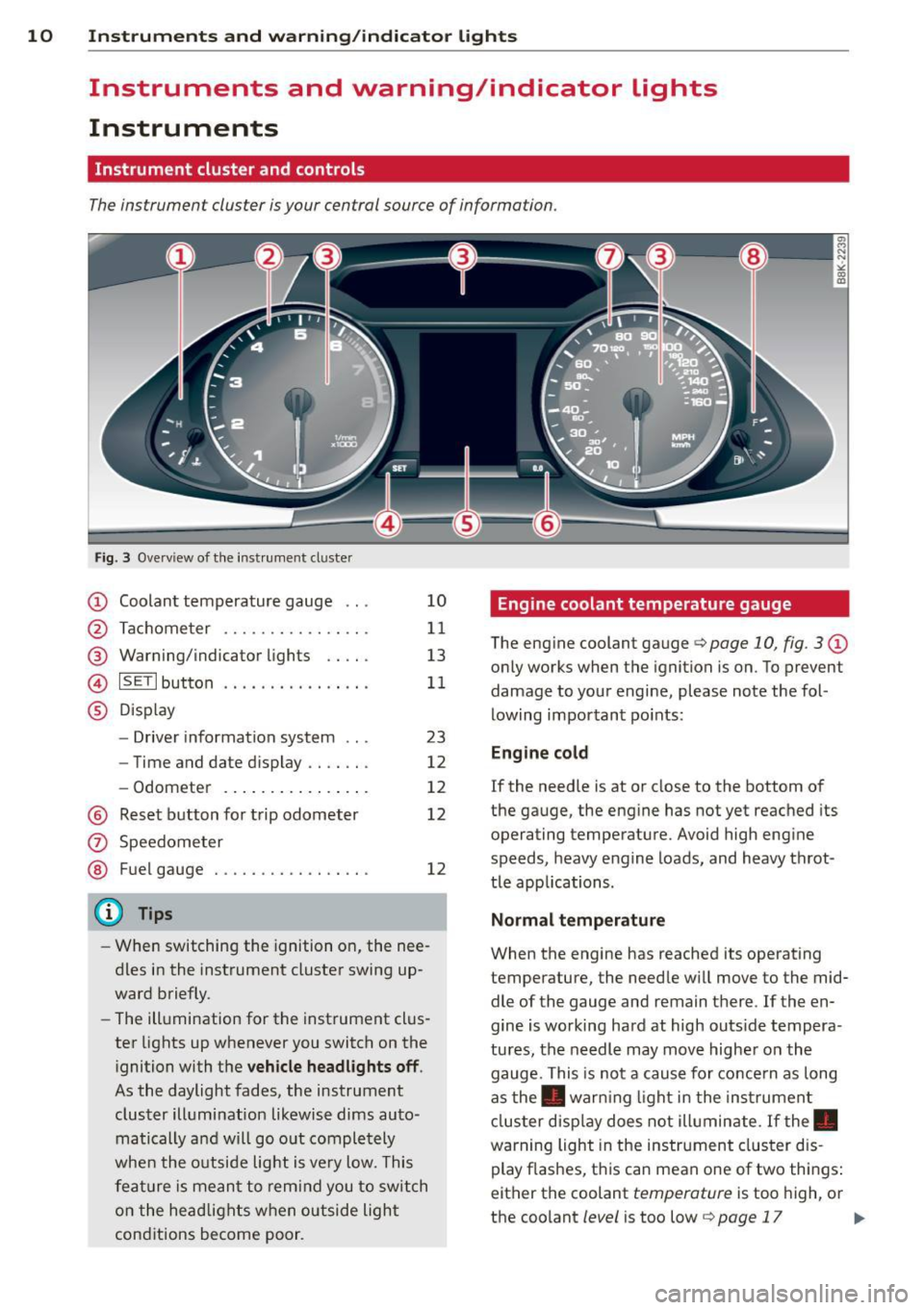
10 Instruments and warning/indicator lights
Instruments and warning/indicator Lights
Instruments
Instrument cluster and controls
The instrument cluster is your central source of information.
Fig. 3 Ove rv iew of the instrument cluster
CD Coolant temperature gauge .. .
@ Tachometer ........... .. .. .
@ Warning/indicator lights .. .. .
© ISETlbutton .... .... .. .... . .
® Display
- Driver information system .. .
- Time and date d isplay .. .. .. .
- Odometer .......... ... .. .
@ Reset button for trip odometer
(z) Speedometer
@ Fuel gauge . .... ..... .. .. .. .
(D Tips
10
11
13
11
23
12
12
12
12
- When switching the ignition on, the nee
dles in the instrument cluster swing up
ward briefly.
- The illumination for the instrument clus
ter lights up whenever you switch on the
i gnition with the
vehicle headlights off .
As the daylight fades, the instrument
cluster illumination likewise dims auto
matically a nd will go out completely
when the outside light is
very low. This
feature is meant to remind you to switch
on the headlights when outside light
conditions become poor .
Engine coolant temperature gauge
The engine coolant gauge q page 10, fig. 3 CD
only works when the ignition is on. To prevent
damage to your engine, please note the fol
lowing important points:
Engine cold
If the needle is at or close to the bottom of
the gauge, the engine has not yet reached its
operating temperature. Avoid high engine
speeds, heavy engine loads, and heavy throt
tle app lications.
Normal temperature
When the engine has reached its operating
temperature, the needle will
move to the mid
dle of the gauge and remain there . If the en
gine is working hard at high outs ide tempera
tures, the needle may
move higher on the
gauge. This is not a cause for concern as long
as the . warn ing light in the instrument
cluster display does not illuminate. If the.
warning light in the instrument cluster dis
play flashes, this can mean one of two things:
either the coolant
temperature is too high, or
the coolant
level is too low¢ page 17 Ill-
Page 13 of 304
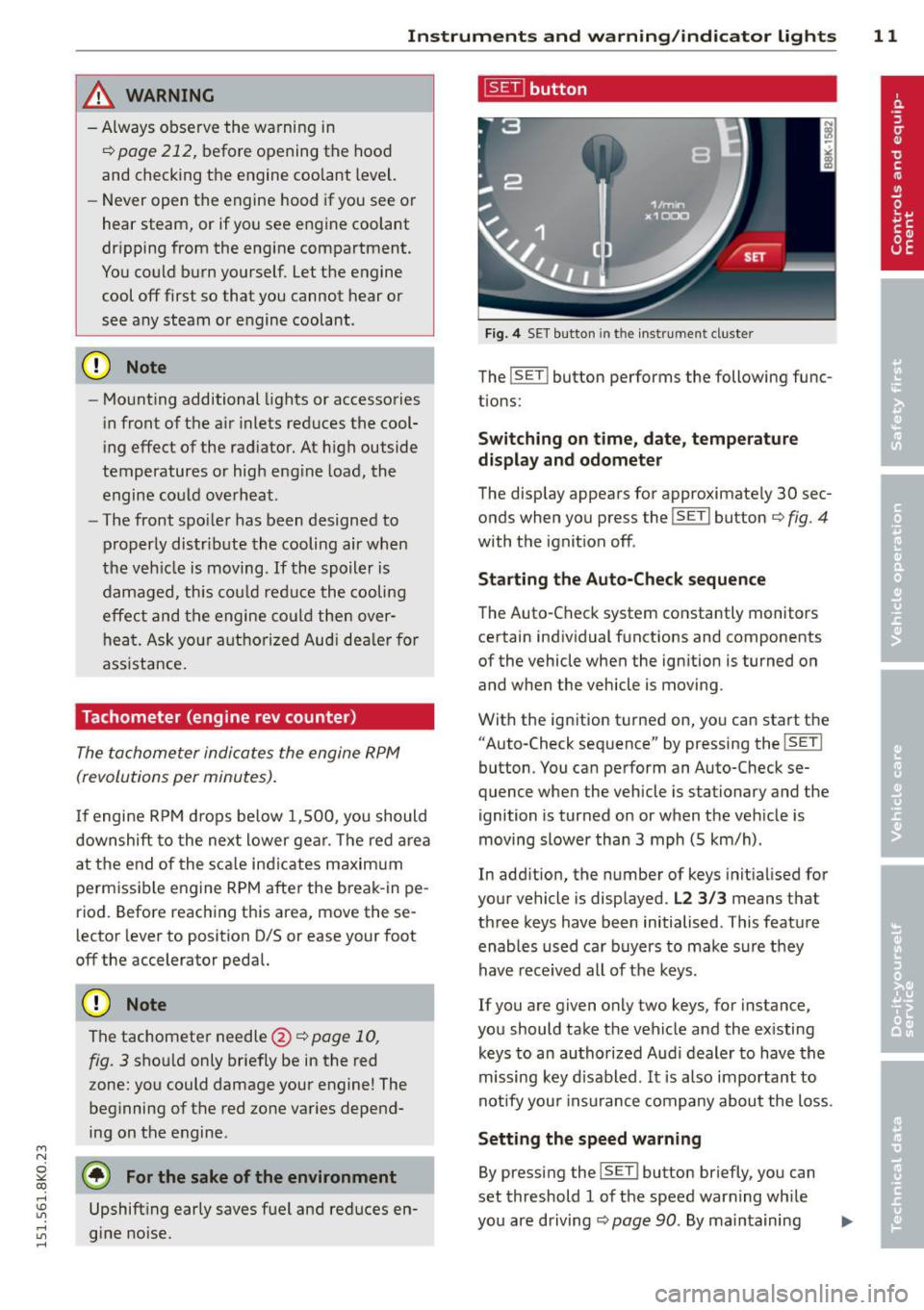
M N
~ co
rl I.O
"' rl
"' rl
Instrument s and warning /indicator lights 11
A WARNING
- Always observe the warning in
c::> page 212 , before opening the hood
and checking the engine coolant level.
- Never open the engine hood if you see or
hear steam, or if you see engine coolant
dripping from the engine compartment.
You could burn yourself. Let the engine
cool off first so that you cannot hear or
see any steam or engine coolant .
(D Note
-Mounting additional lights or accessories
in front of the air inlets reduces the cool
ing effect of the rad iator. At high outside
temperatures or high eng ine load , the
engine could overheat.
- The front spoiler has been designed to
properly distribute the cooling air when
the veh icle is moving .
If the spoiler is
damaged , this cou ld reduce the cooling
effect and the engine co uld then over
heat. Ask your authorized Aud i dealer for
assistance.
Tachometer (engine rev counter)
The tachometer indicates the engine RPM
(revolutions per minutes).
I f engine RPM drops below 1,500, you should
downshift to the next lower gear . T he red area
at the end of the scale indicates maximum
perm issible engine RPM after the break-in pe
riod. Before reaching this area, move these
lector lever to position 0/5 or ease your foot
off the accelerator pedal.
@) Note
The tachometer needle@c::> page 10 ,
fig. 3 shou ld only briefly be in the red
zone: you could damage your engine! The
beg inning of the red zone varies depend-
ing on the engine .
@) For the sake of the environment
Upshifting early saves fuel and reduces en
gine noise.
~ button
Fig. 4 SET button in th e ins trume nt cluster
The !SET ! button performs the following func
tions:
Switching on time, date, temperature
display and odometer
The display appears for approximate ly 30 sec
onds when you press the
I S ET ! button c::> fig . 4
with the ignit ion off .
Starting the Auto-Check sequence
The Auto-Check system constantly monitors
certa in individual functions and components
of the vehicle when the ignition is turned on
and when the vehicle is moving .
With the ignition turned on, you can start the "Auto-Check sequence" by pressing the
! SE T!
button . You can perform an Auto-Check se
quence when the vehicle is stationary and the
ignition is turned on or when the vehicle is
moving slower than 3 mph (5 km/h).
In addition, the number of keys initialised for
your vehicle is displayed.
L2 3 /3 means that
three keys have been initialised . This feature
enables used car buyers to make sure they
have received all of the keys.
If you are given only two keys, for ins tance ,
you should take the vehicle and the ex isting
keys to an authorized Audi dealer to have the
missing key d isabled .
It is also important to
notify your insurance company about the loss.
Setting the speed warning
By pressing the !SET ! button briefly, you can
set threshold 1 of the speed warning wh ile
you are driving
c::> page 90 . By maintaining II>
Page 19 of 304
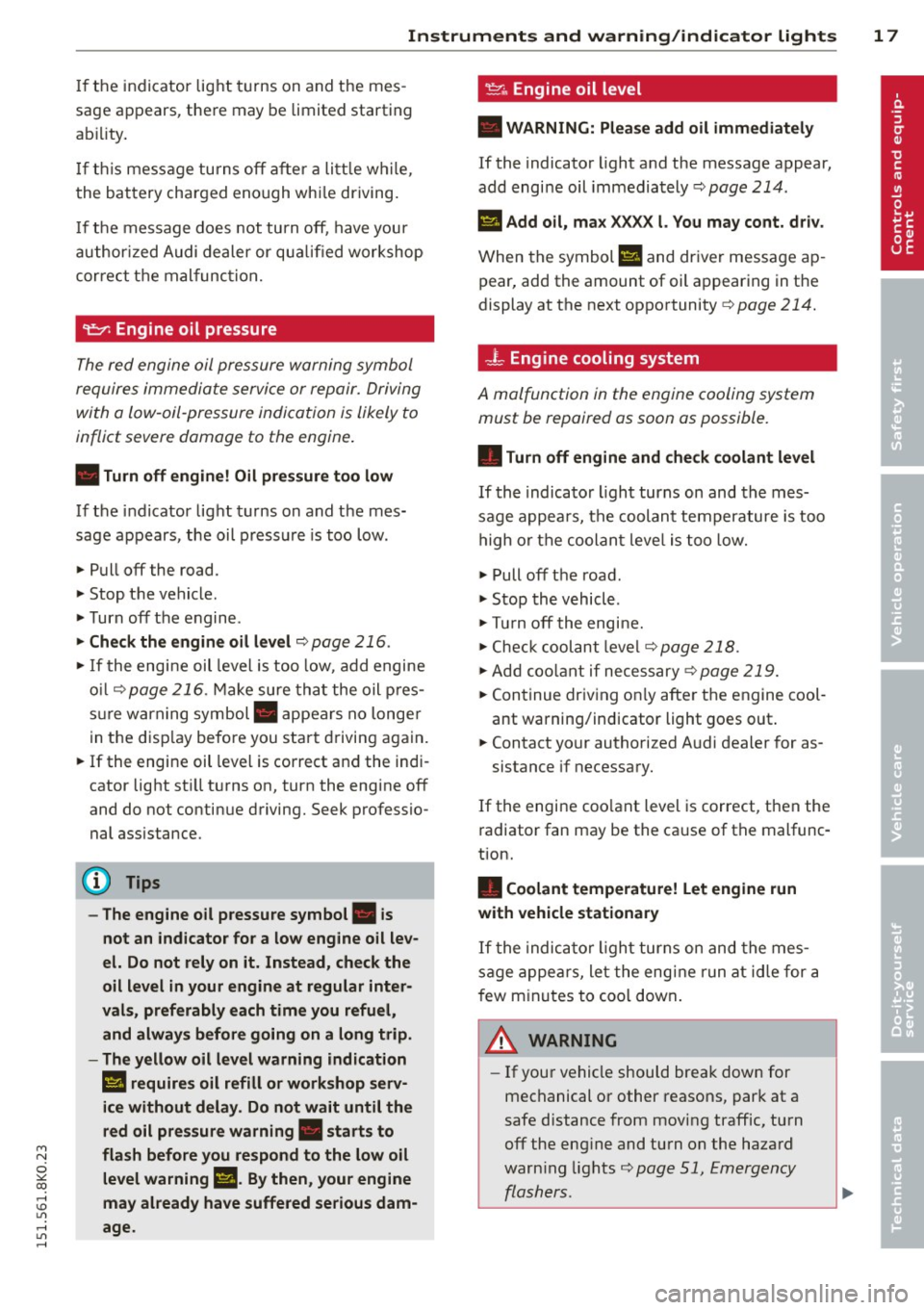
"" N
0 ::.,: co ,...., \!) 1.1'1 ,...., 1.1'1 ,....,
Instruments and warning/indicator lights 17
If the indicator light turns on and the mes
sage appears, there may be limited starting
abi lity.
If th is message turns
off after a litt le while,
the battery charged enough whi le driving.
If the message does not turn
off, have your
authorized Audi dealer or qua lified workshop
correct the malfunction.
~ Engine oil pressure
The red engine oil pressure warning symbol
requires immediate service or repair. Driving
with a Low-oil-pressure indication is Likely to
inflict severe damage to the engine .
• Turn off engine! Oil pressure too low
If the indicator light turns on and the mes
sage appears, the oil pressure is too low.
.,. Pull
off the road.
.,. Stop the vehicle .
.,. Turn
off the engine .
.,. Check the engine oil level ¢ page 216 .
.,. If the engine oil level is too low, add engine
oil ¢
page 216 . Make sure that the oil pres
sure warn ing symbol. appears no longer
in the disp lay before you start driving again.
.,. If the engine oil level is correct and the indi
cator light st ill turns on, turn the engine
off
and do not continue driving. Seek professio
nal assistance.
(l) Tips
- The engine oil pressure symbol. is
not an indicator for a low engine oil lev
el. Do not rely on it. Instead, check the
oil level in your engine at regular inter
vals, preferably each time you refuel,
and always before going on a long trip.
- The yellow oil level warning indication
II requires oil refill or workshop serv·
ice without delay. Do not wait until the
red oil pressure warning. starts to
flash before you respond to the low oil
level warning
l!I. By then , your engine
may already have suffered serious dam
age.
~ Engine oil level
• WARNING: Please add oil immediately
If the indicator light and the message appear,
add engine oil immediately¢
page 214.
II Add oil, max XXXX l. You may cont. driv .
When the symbol l!I and driver message ap
pear, add the amount of oil appearing in the
display at the next opportunity ¢
page 214.
-L Engine cooling system
A malfunction in the engine cooling system
must be repaired as soon as possible.
• Turn off engine and check coolant level
If the indicator light turns on and the mes
sage appears, the coolant temperature is too
high or the coolan t leve l is too low .
.,. Pull
off the road .
.,. Stop the vehicle .
.,. Tu rn
off the engine .
... Check coolant level¢
page 218 .
.,. Add coolant if necessary¢ page 219.
.,. Continue driving on ly after the engine cool
ant warning/indicator light goes out .
.,. Contact your authorized Audi dealer for as-
sistance if necessary.
If the engine coo lant level is correct, then the
radiator fan may be the cause of the malfunc
tion.
• Coolant temperature! Let engine run
with vehicle stationary
If the indicator light turns on and the mes
sage appears, let the engine run at id le for a
f ew m inutes to coo l down .
_& WARNING
-If your vehicle should break down for
mechanical or other reasons, park at a
safe distance from moving traffic, turn
off the eng ine and turn on the hazard
warn ing lights
¢page 51, Emergency
flashers.
-
Page 20 of 304

18 Instrum ent s and w arn ing /indic ato r light s
-Never open the hood if you see or hear
steam or coolant escaping from the en
gine compartment -you risk being scald
ed . Wait until you can no longer see or
hear steam or coo lant escaping.
- The engine compartment of any veh icle
is a dangerous area . Before you perform
any work in the engine compartment,
turn of the eng ine and allow it to cool.
Follow the wa rning sticke rs
qpage 212.
{[) Note
Do not co ntinue driving if the. symbol
illuminates . There is a malfunct ion in the
engine cooling system -you could damage
your eng ine .
@-Steering column lock
• Stee ring def ective! D o not drive vehicle!
If the indicator light turns on and the mes
sage appears, the re is an elect ronic steer ing
col umn lock ma lfunction. You ca nnot switch
the ign ition on.
Do
not tow your vehicle because it ca nnot be
steered. Seek professional ass istance.
Ill! Ste ering lock: Contact d ealer!
If the indicator light t urns on and the mes
sage appears, there is an electronic steer ing
column lock malfunction.
Drive to yo ur authorized Audi dea le r immedi
ately to have the malfunction corrected .
A WARNING
-
Your vehicle must not be towed in the
event of a malfunct ion in the electron ic
steering column lock because it cannot be
steered due to the locked steering .
If it is
tow ed w ith th e stee ring lock ed, there is
the risk of a n accident .
©-Ignition lock
• Ignition lock d efe ctive. Contact d eal er! If
the indicator light turns on and the mes
sage appears, do
not switch the ignition off
because you may not be ab le to sw itch it on
again.
Drive to your authorized Audi dealer immedi
ately to have the ma lfunction corrected.
On vehicles with conve nience key*, the engine
shou ld not be switched off using the
I STAR T ENGINE ST OPI button because the en
gine cannot be started again after the ignition
has been switched off.
(D Tips
The symbol's appearance might be differ
ent in some mode ls.
FJ,/ ~ Electronic Stabilization Control
(ESC)
If the Jj] ind icator light blinks while driv ing ,
the ESC or ASR (Anti-Slip Regulation) is active
ly regu lating.
If the D] ind icator light turns on , the system
has switched the ESC off . In this case, you can
switch the ign ition off and then on to switch
the ESC on aga in. The ind icator lig ht tu rns off
whe n the system is functioning f ully.
If the
II ind icator light turns on, ESC was re
stricted or sw itched off us ing the !.$
O FFI but
ton
q page 185 .
Stabilizat ion control (ESC /ABS ): Fault! See
own er' s m anual
If the indicator light DJ and the ABS indicator
light
fJD (USA models) ; tiJ (Canada models)
turn on and the message appears, the ABS or
electron ic different ial lock is malfunctioning .
Th is also causes the ESC to malfunction . The
brakes still function with their normal power,
but A BS is not active.
D rive to your author ized Audi dealer immedi
ately to have the malfunction corrected .
For more info rmation about the ESC
q page 185 .
Page 80 of 304
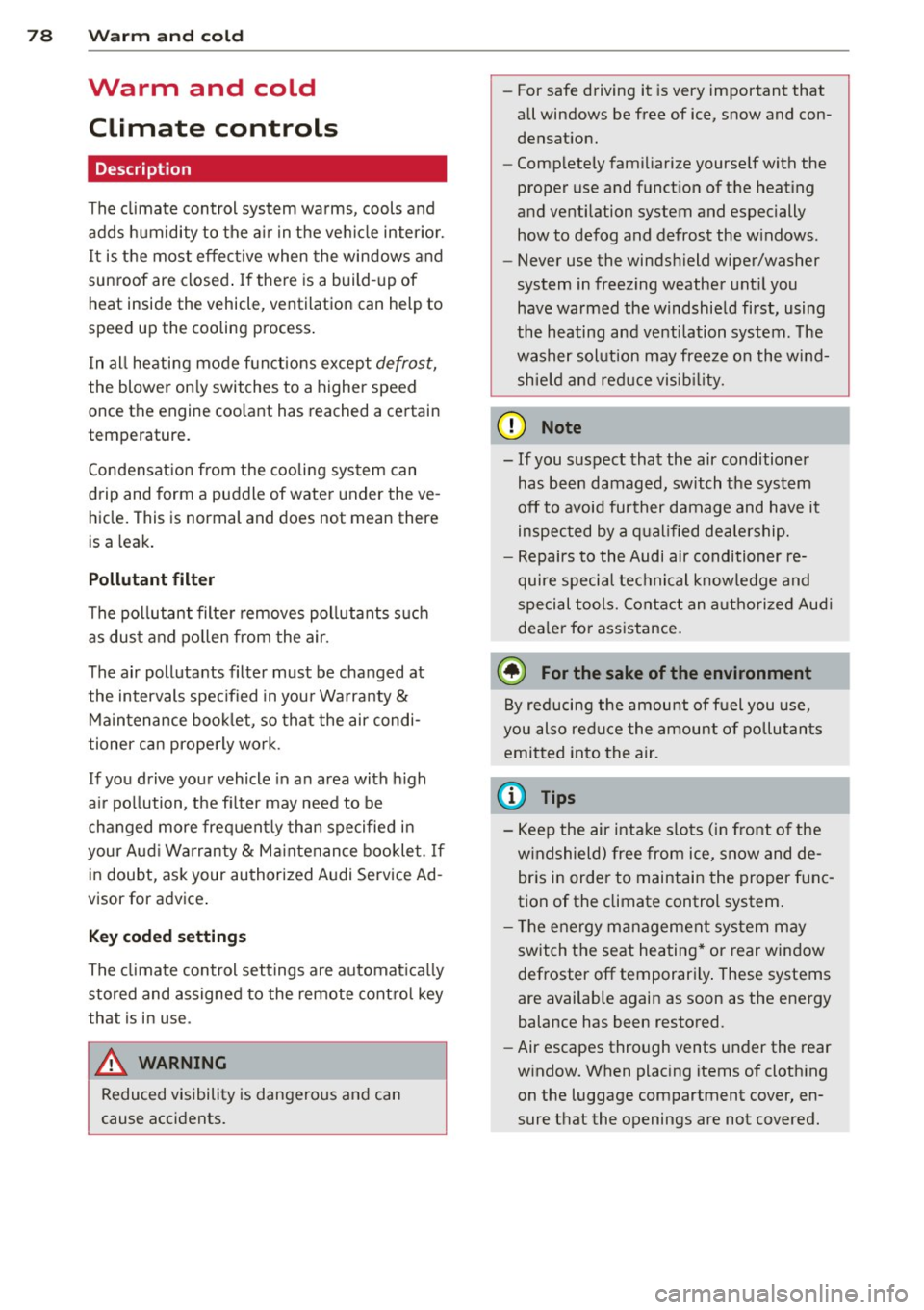
78 Warm and cold
Warm and cold Climate controls
Description
The climate control system warms, cools and
adds humidity to the air in the vehicle interior.
It is the most effect ive when the windows and
sunroof are closed . If there is a build-up of
heat inside the vehicle, ventilation can help to
speed up the cooling process.
I n all heating mode functions except
defrost,
the blower on ly switches to a higher speed
once the engine coolant has reached a certain
temperature.
Condensat ion from the cooling system can
drip and form a puddle of water under the ve
hicle. This is normal and does not mean there
is a leak.
Pollutant filter
The pollutant filter removes pollutants s uch
as dust and pollen from the air.
The air pollutants filter must be changed at
the intervals spec ified in you r Warranty
&
Maintenance booklet, so that the air condi
tioner can properly work.
If you drive your vehicle in an area with h igh
a ir po llution, the fi lter may need to be
changed more frequent ly than specified in
your Aud i Wa rranty
& Ma intenance booklet. If
in doubt, ask your authorized Audi Service Ad
visor for advice .
Key coded settings
The climate control settings are automat ically
stored and assigned to the remote control key
that is in use.
A WARNING
Reduced visibility is dangerous and can
cause accidents.
-
- For safe driving it is very important that
all windows be free of ice, snow and con
densation.
- Comp letely familiarize yourself with the
proper use and function of the heating
and ventilation system and especially how to defog and defrost the windows.
- Never use the windshield wiper/washer
system in freez ing weather unt il you
have warmed the windshield first, using
the heating and ventilation system. The
washer solution may freeze on the wind shie ld and reduce visib ility.
(D Note
- If you suspect that the air conditioner
has been damaged, switch the system
off to avoid further damage and have it
inspected by a qualified dealership.
- Repairs to the Audi air conditioner re
quire special technical know ledge and
special tools. Contact an authorized Aud i
dea ler fo r assistance.
@ For the sake of the environment
By reducing the amount of fuel you use,
you also reduce the amount of pollutants
emitted into the air.
(D Tips
-Keep the air intake s lots (in fro nt of the
w indshield) free from ice, snow and de
bris in order to maintain the proper func
tion of the climate control system.
- T he energy management system may
switch the seat heating* or rear window
defroster off temporarily . These systems
are available again as soon as the energy
balance has been restored.
- Air escapes through vents under the rear
window. When placing items of clothing
on the luggage compartment cover, en
sure that the openings are not covered.
Page 202 of 304

200 Trailer towing
Tire pressure
When towing a trai le r, inflate the tir es of your
vehicle to the cold tire pressure listed under
"Full load" on the label located on the driver 's
side B-pillar (visible when the door is open).
Inflate trailer tires to trailer and tire manufac
turers' specifications.
Lights
The headlight settings should be checked with
the trailer attached before dr iving off. Check
to make sure both vehicle and tra iler lights
are working properly.
Safety chains
Be sure trailer safe ty cha ins are properly con
nected from the trailer to the hitch on the ve
hicle. Leave eno ugh slack in the chains to per
mit turning corners. When you install safety
cha ins, make sure they w ill not drag on the
road when you are driving.
The chains shou ld cross under the trai ler
tongue to prevent it from dropping in case of
separation from the hitch.
Driving instructions
Driving with a trailer always requires extra
care and consideration.
To obtain the best possible handling of vehicle
and trai ler, p lease note the following:
.,. Do not tow a loaded trailer when your car it
self is not loaded .
.,. Be especia lly careful when passing other
vehicles .
.,. Observe speed limits .
.,. Do not drive at the maximum permissible
speed.
.,. Always apply brakes early.
.,. Monitor the temperature gauge.
Weight distribution
Towing a loaded trai ler with an empty car re
sults in a highly unstable distribution of
weight . If this cannot be avo ided, drive at very
low speeds only to avoid the risk of losing
steering control. A "ba
lanced" rig is easier to operate and con
tro l. This means that the tow vehicle should
be loaded to the extent possible and permissi
ble, while keep ing the trai ler as light as possi
ble under the c ircumstances. Whenever poss i
ble, transfer some cargo to the luggage com
partment of the tow veh icle while obse rving
tongue load requi rements and vehicle load ing
considerations.
Speed
The higher the speed, the more d iff icu lt it be
comes for the driver to control the rig. Do not
drive at the maximum permissible speed. Re
duce your speed even more if load, weather or
wind conditions are unfavorable -pa rticularly
whe n going downhill.
Reduce veh icle speed
immediately if the trail
er shows the slightest s ign of sway ing.
Do not
try to stop the swaying by accelerating.
Observe speed limits . In some areas, speeds
for vehicles tow ing tra ilers are lower than for
regular vehicles .
Always apply brakes early. When driving
downh ill, shift into a lower gear to use the en
gine braking effect to slow the vehicle. Use of
the brakes alone can cause them to overheat
and fail.
Coolant temperature
The coolant temperature gauge c> page 10
must be observed carefully . If the needle
moves close to the upper end of the scale, re
duce speed immediately and/or turn off the
air conditioner.
If the coolant temperature warning light •
i n the i nstrument cluster starts flashing, pull
off the road, stop and let the engine
idle for
abo ut two minutes to prevent heat build-up .
_& WARNING
Anyone not properly restrained in a mov
ing vehicle is at a much greater risk in an
accident . Never let anyone ride in your car
who is not p roper ly wea ring the restraints
provided by Audi.
-
Page 214 of 304
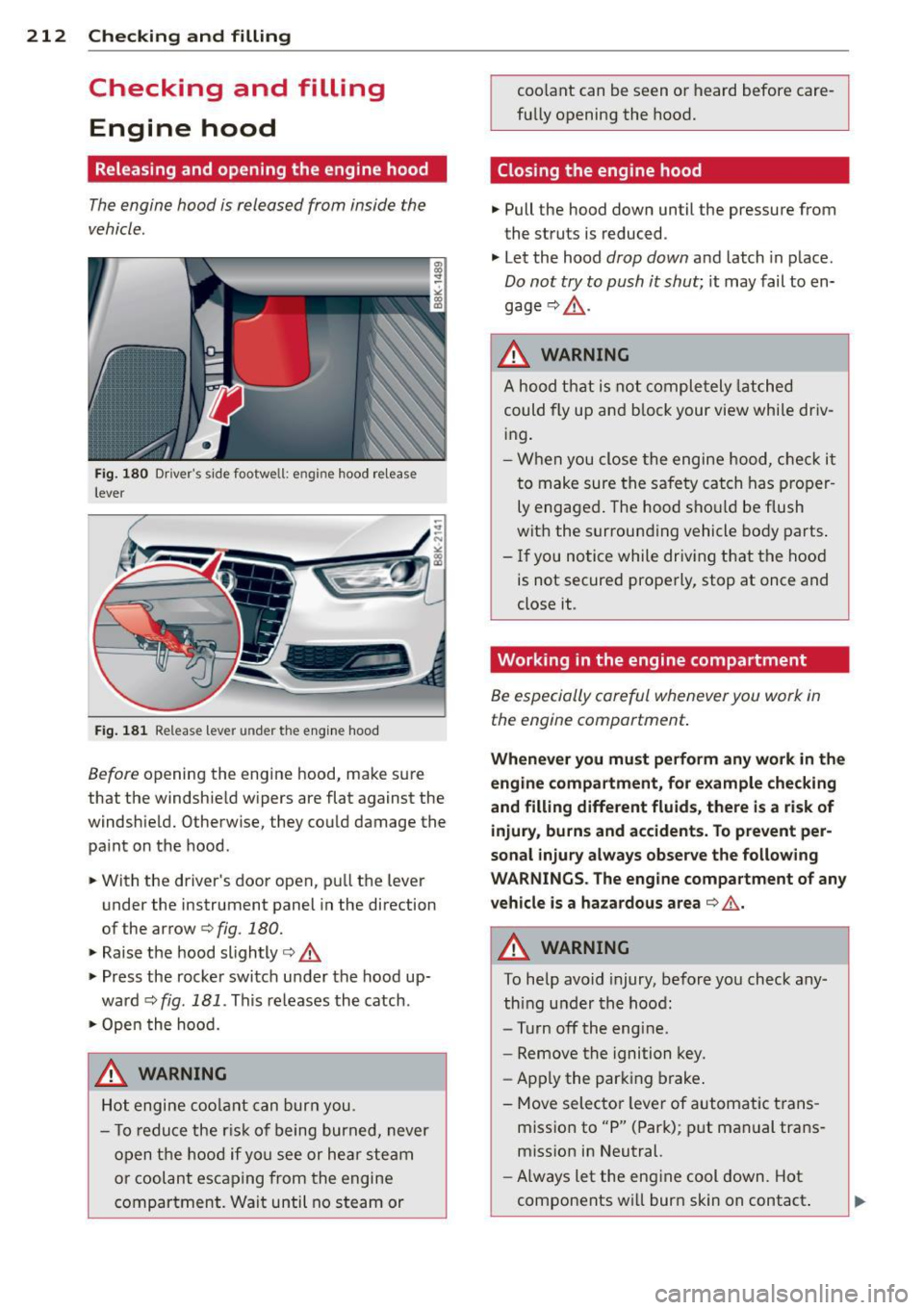
212 Checking and filling
Checking and filling
Engine hood
Releasing and opening the engine hood
The engine hood is released from inside the
vehicle .
Fig. 180 Driver's side footwe ll: e ngin e hood release
lever
... -- - -=-
Fig. 181 Release lever u nde r the engine hood
Before opening the engine hood, make sure
that the windshield wipers are flat against the
windshield. Otherwise, they could damage the
pa int on the hood.
... With the driver's door open, pull the lever
under the instrument panel in the direction
of the arrow
c> fig . 180.
... Raise the hood slightly c> .&,
... Press the rocker switch under the hood up
ward
c> fig . 181 . This releases the catch.
... Open the hood.
A WARNING
Hot engine coo lant can burn you.
- T o reduce the risk of being burned, never
open the hood if you see or hear steam
or coolant escaping from the engine
compartment. Wait until no steam or coo
lant can be seen or heard before care
fully opening the hood.
Closing the engine hood
... Pull the hood down until the pressure from
the struts is reduced .
... Let the hood
drop down and latch in place.
Do not try to push it shut; it may fail to en
gage
c> .&, .
A WARNING
-
A hood that is not completely latched
could fly up and b lock your view while driv
ing.
- When you close the engine hood, check it
to make sure the safety catch has proper
ly engaged . The hood shou ld be flush
with the surrounding vehicle body parts.
-If you notice while driving that the hood
is not secured properly, stop at once and
close it.
Working in the engine compartment
Be especially careful whenever you work in
the engine compartment.
Whenever you must perform any work in the
engine compartment, for example checking
and filling different fluids , there is a risk of
injury , burns and accidents. To prevent per
sonal injury always observe the following
WARNINGS. The engine compartment of any
vehicle is a hazardous area
c> ,&..
A WARNING
-To help avoid injury, before you check any-
thing under the hood:
- Turn off the engine.
- Remove the ignition key.
- Apply the parking brake.
- Move selector lever of automatic trans-
mission to "P" (Park); put manual trans
mission in Neutral.
- Always let the engine cool down. Hot
components will burn skin on contact .
Page 215 of 304
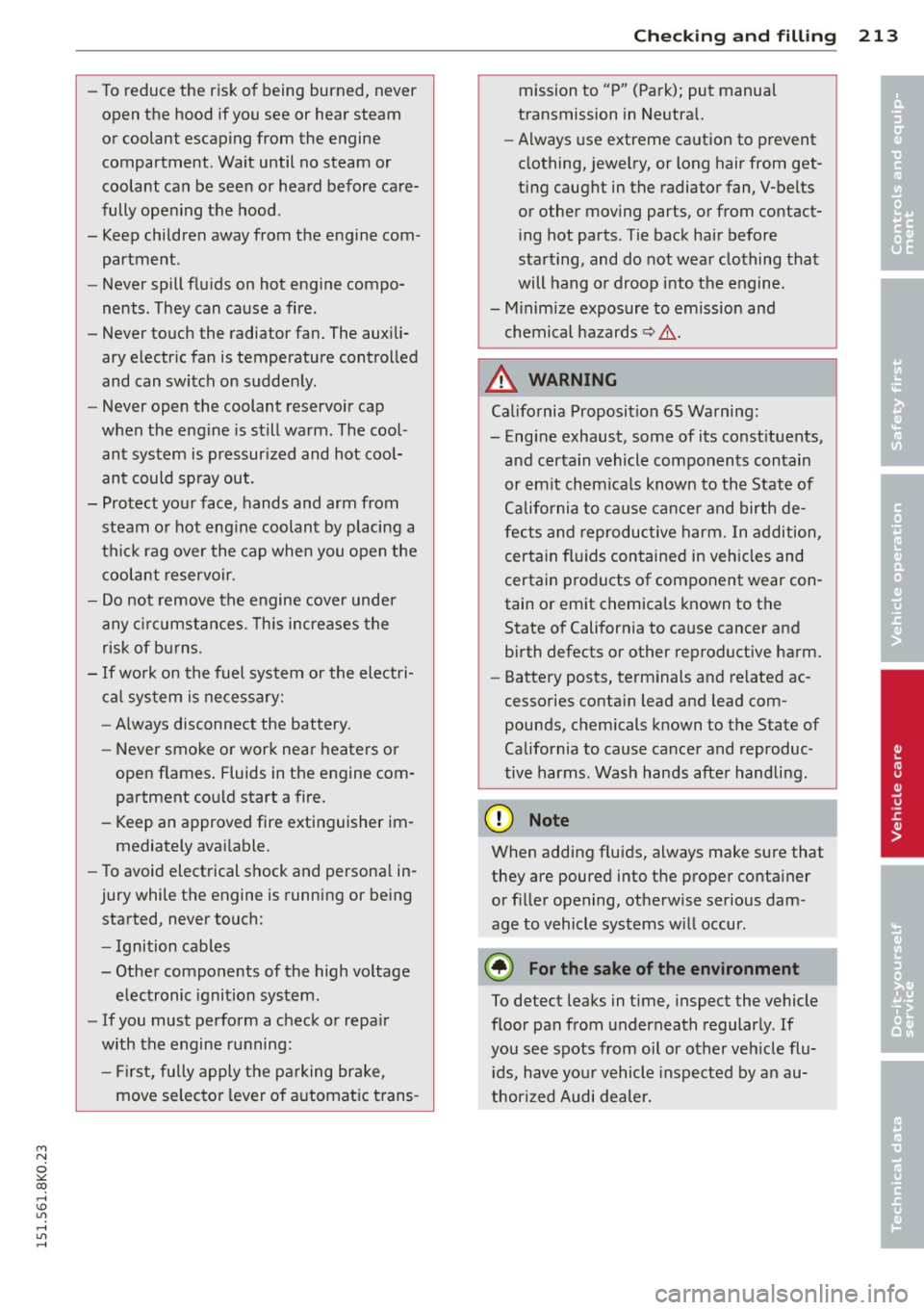
"" N
0 ::.,: co ,...., \!) ..,.,
,...., ..,., ,....,
-To reduce the r isk of being burned, never
open the hood if you see or hear steam
or coolant escaping from the engine
compartment . Wait until no steam or
coolant can be seen or heard before ca re
fully opening the hood .
- Keep children away from the engine com
partment.
- Never spill flu ids on hot engine compo
nents. They can cause a fire .
- Never touch the radiator fan. The aux ili
ary e lectr ic fan is temperature controlled
and can switch on suddenly .
- Never open the coolant reservoir cap
when the eng ine is still warm . The cool
ant system is pressur ized and hot coo l
ant could spray out.
- Protect your face, hands and arm from
steam or hot eng ine coolant by placing a
thic k rag over the cap when you open the
coolant reservoir.
- Do not remove the engine cover under
any c ircumstances. Th is increases the
risk of bu rns.
- If wo rk on the fuel system or the electri
cal sys tem is ne cessary:
- Always disconnect the battery.
- Never smoke or work near heaters or
open flames . Fluids in the engine com
partment co uld start a fire.
- Keep an approved fire extinguisher im
mediately ava ilable.
- To avoid electrical s hock and persona l in
jury while the engine is running or being
started, never touch:
- Ignition cables
- Other components of the high voltage
electronic ignition system.
- If you must perform a check or repa ir
with the engine running:
- Fir st, fully apply the parking brake,
move se lector lever of a utomatic trans-
Checkin g and fillin g 213
mission to "P" (Park); put manual
transmission in Neutral.
- Always use extreme caution to prevent
clothing, jewe lry, or long hair from get
ting caught in the radiator fan, V-be lts
or other moving parts, or from contact i ng hot parts . Tie back hair before
starting, and do not wear clothing that
will hang o r droop into the engine .
- Minimize exposure to emission and
chemical hazards~&. .
A WARNING
California Proposition 65 Warning:
- Engine exhaust, some of its const ituents,
a nd certain vehicle components contain
or emit chemicals known to the State of
Ca lifornia to cause cance r and birth de
fects and reproductive harm. In addition, certain fl uids contained in veh icles and
certain products of component wear con
tain or emit chemica ls known to the
State of California to cause cancer and
birth defects or other reproductive harm.
- Battery posts, terminals and related ac
cessories conta in lead and lead com
pounds, chemicals known to the State of
California to cause cancer and reproduc
tive harms. Wash hands afte r handling.
Q) Note
When adding f lu ids, always make sure that
they are poured into the proper conta iner
or f iller opening, otherwise serious dam
age to vehicle systems w ill occur .
@ For the sake of the environment
To detect leaks in time, inspect the vehicle
floor pan from underneath regular ly . If
you see spots from oil or other veh icle flu
i ds, have your vehicle inspected by an au
thorized Audi dealer. •
•
Page 216 of 304

214 Checking and filling
Engine compartment
Engine compartment
These are the most important items that you can check.
Fig. 182 Typical layout for containers and eng ine o il filler cap
(D Eng ine o il filler cap ("1::::r.) . . . . . 216
@ Jump start point(+) under a cov-
er .. .. .... ... ....... .... ..
224, 275
@ Bra ke fluid reservo ir (0)) . . . . . 221
@ Coolant expansion tank (-L) . . . 219
® Jump start point(-) with hex
head sc rew ..... .......... ..
224, 275
® W indshield/headlight* washer
. (" ') container o ....... . ... .. . 225
The pos ition o f the engine o il fi lling hole
¢ fig . 182 (item @) can differ depending on
the eng ine design.
A WARNING
Before yo u check anything in the engine
compartment, always read and heed all
WARNINGS
¢ .&. in Working in the engine
compartment on page 212.
-
Engine oil
· Engine oil specifications
The engine oil used must conform to exact
specifications.
The service interval disp lay in the instrument
cluster of your vehicle will inform you when it
is time for a n oil change . We recommend that
you have your oil changed by an authorized
Audi Se rv ice Adv isor.
If you have to top off the o il between o il
changes, use the Audi o il quality standard
specified in the tab le.
Audi oil quality standard
Gasoline
VW 502 00 or
engine vw 504 00
Page 220 of 304
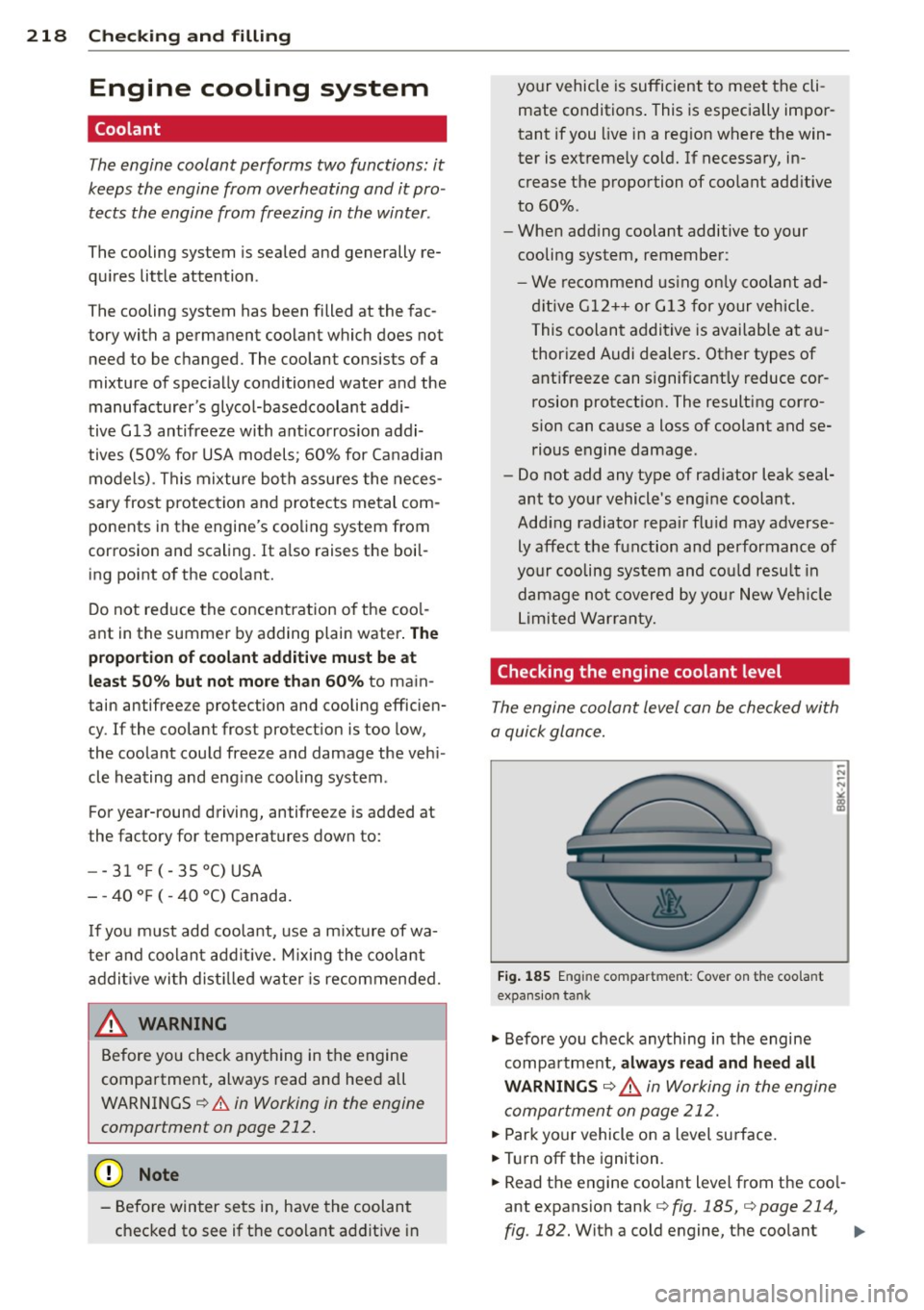
218 Check ing and filling
Engine cooling system
Coolant
The engine coolant performs two functions: it
keeps the engine from overheating and it pro
tects the engine from freezing in the winter .
The cooling system is sealed and generally re
quires little attention.
The cooling system has been filled at the fac
tory with a permanent coolant which does not need to be changed. The coolant consists of a
mixture of specially conditioned water and the
manufacturer's glycol-basedcoolant addi-
tive G13 antifreeze with ant icorrosion addi
tives (50% for USA models; 60% for Canadian models) . This mixture both assures the neces
sary frost protection and protects metal com
ponents in the engine's cooling system from
corrosion and scaling.
It a lso raises the boil
ing point of the coo lant.
Do not reduce the concentration of the coo l
ant in the summer by adding plain water .
The
pr opor tion of coolant add itiv e m ust be at
l eas t 50% but not more than 60%
to main
tain antifree ze protection and cooling efficien
cy. If the coolant frost protection is too low,
the coolant could freeze and damage the veh i
cle heating and eng ine cooling system .
For year-round driving, antifree ze is added at
the factory for temperatures down to:
- -31°F(-35°C)USA
- - 40 ° F ( - 40 °C) Canada.
I f you must add coo lant, use a m ixture of wa
ter and coolant addit ive. M ixing the coolant
addit ive with dist illed water is recommended.
_& WARNING
Before you check anything in the engine
compartment, always read and heed all
WARNINGS
~ &. in Working in the engine
compartment on page 212.
(D Note
- Before winter sets in, have the coolant
checked to see if the coolant additive in
-
your vehicle is sufficient to meet the climate conditions . This is especia lly impor
tant if you live in a reg ion where the win
ter is extreme ly cold. If necessary, in
crease the proportion of coolant additive
to 60% .
- When adding coolant additive to your
cooling system, remember :
- We recommend us ing on ly coolant ad
d itive G12 ++ or G13 for your vehicle.
This coolant addit ive is availab le at a u
thorized Audi dealers. Other types of
antifreeze can significantly reduce cor rosion protection. The resulting corro
sion can cause a loss of coolant and se
rious engine damage .
- Do not add any type of radiator leak seal
ant to your vehicle's engine coolant.
Add ing radiator repa ir flu id may adverse
ly affect the function and performance of
your cooling system and could resu lt in
damage not covered by your New Veh icle
Limited Warranty.
Checking the engine coolant level
The engine coolant level can be checked with
a quick glance.
F ig . 1 85 Engine compar tmen t: Cover on the coo la n t
expans io n t ank
.,. Before you check anything in the engine
compa rtment,
alwa ys read and h eed all
W ARNING S ~ ,& in Working in the engine
compartment on page 212.
.,. Park your vehicle on a level surface .
.,. Turn off the ignition.
.,. Read the engine coolant level from the coo l
ant expansion tank
c:> fig . 185, c:> page 214,
fig . 182.
With a cold engine, the coolant Iii>-